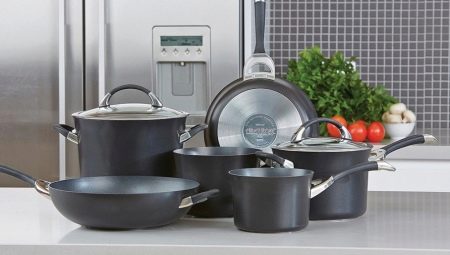Cookware is available in every home. Today, manufacturers give the opportunity to choose kitchen utensils from a variety of materials. Cast iron cookware is famous for its ability to store heat for a long time, as a result of which dishes that are amazing in taste are obtained.
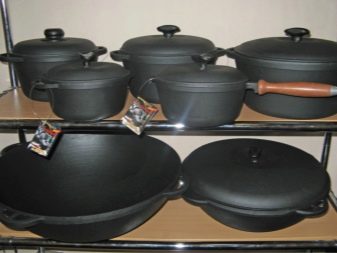

Features, pros and cons
Cast iron is a material that has been used for more than two thousand years. Our ancestors quickly realized that such a material perfectly stores heat, does not melt and does not lose its properties for a long time, so cooking in it is easy and pleasant. Before the appearance of stoves, when people cooked in a stove or hearth, only cast-iron pots or pans were usedthat were suspended or mounted on legs. When the first slabs were developed, flat-bottomed dishes appeared.

In the 60-70 years of the XX century, cast-iron utensils began to gradually be replaced by enameled and aluminum. The popularity of cast iron began to decline, more and more housewives preferred modern news to a glorious past.
But in recent years, the situation began to change again, many cooks admit that the most delicious pilaf, soup or fries are obtained only in cast-iron dishes.
Thanks to this, pots, pans and casseroles from this material are again in demand and loved.
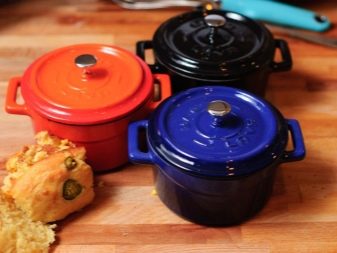

But before you go to the store for a purchase, you should familiarize yourself with the advantages and disadvantages of modern cast iron.
It has the following advantages:
- a cast-iron pan will warm up for a rather long time, which means that uniform cooking and heating of all products are guaranteed;
- the heat diverges evenly: the bottom and walls are equally hot, the heat does not go anywhere, so the food in such a pan will languish, saturated with aromas from all sides;
- cast iron has the property of slow cooling, therefore, even turning off the stove, you allow the dish to cook further for some time and “go”;
- modern models have a non-stick coating that helps dishes not to burn even when cooking without fat;
- material is not afraid of high temperatures, so in a pot made of cast iron, you can cook food even at the stake.
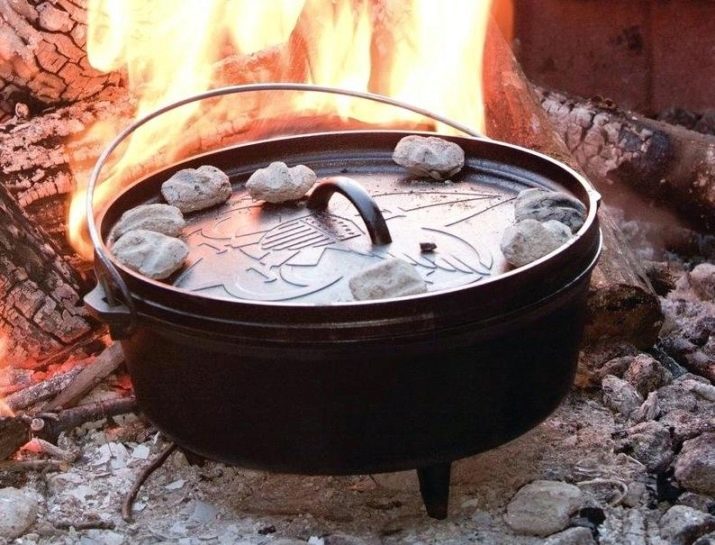
Cons are as follows:
- this material is quite heavy, even a one-liter saucepan will weigh about two kilograms, let alone models for a large family, from three liters or more;
- it is better not to drop the dishes from cast iron - despite the ostentatious hardness, the utensils can crack;
- models without coating have the property of porosity, that is, they absorb all the smells of food, which will then be difficult to get rid of;
- cast iron pots, when used improperly, quickly become rusty, which makes further use problematic;
- unlike good heat tolerance, cast iron will not be able to "survive" a sharp drop, so it is better not to pour ice water into red-hot dishes.
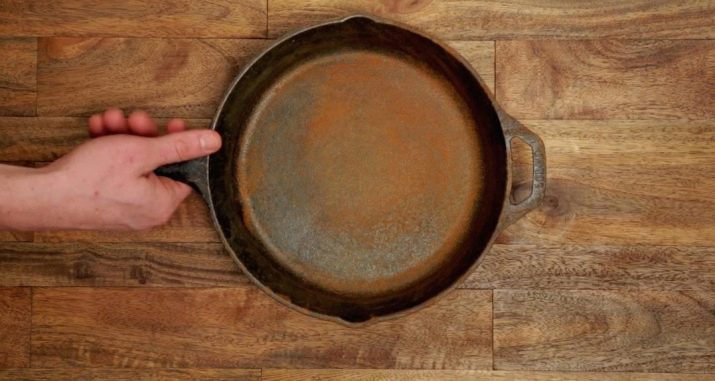
Coverage Options
Today, cast iron cookware begins a new round of its existence. Manufacturers attract users not only with the indisputable advantages of such utensils, but also with the variety of coatings that open up new cooking possibilities.
Without cover
Cast pots even at the production stage are coated with a special lubricant that prevents rust from forming.
As already noted, such products are porous, so they should be prepared before use. The grease is washed off, and the pan is thoroughly calcined.
But even after calcination, the uncoated model is not suitable for all types of dishes. Experts recommend frying in it, and not cooking. The fact is that when you calcine the product, it will have a light oil layer, which, when cooking a liquid dish, will begin to break down, and the fat will surely fall into the food, ruining its taste.

In addition, in such utensils it is not advised to cook acidic dishes: sour cream sauces, tomato paste and so on.
But in it you can make a delicious pilaf, bake a bird, cook roast. And also remember that with rare use, cast iron will begin to secrete an unpleasant odor of rancid oil. If you find such a nuisance, in a bowl you need to boil water for 10-15 minutes, and then anneal it again.

Non-stick
Non-stick coating can be natural and artificial. The natural coating is made in the conditions of the enterprise. This means that the dishes have already been calcined at the factory and an oil layer has been applied. In addition, it is not necessary to calcine, it is recommended to only lightly grease with oil. By the way, it is also not recommended to cook in such a pan, and fry with a minimum amount of fat.
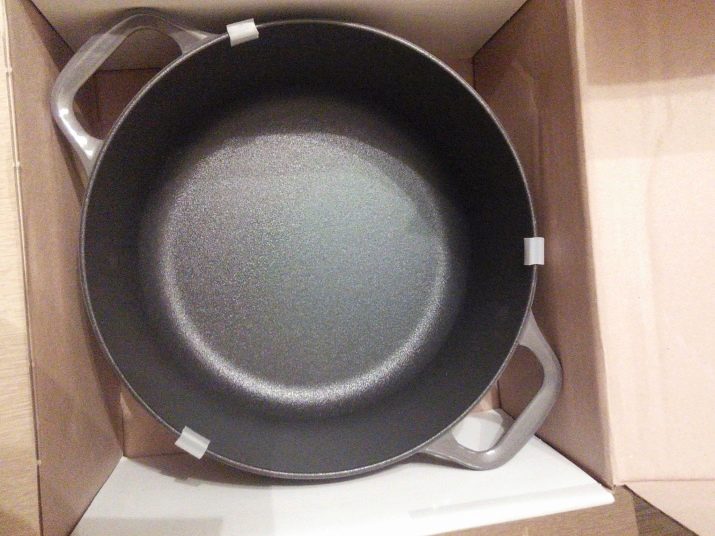
The second type of coating, artificial, is divided into several types.
- Ceramic. Great for those who like stewed or baked food. You can cook almost without fat. The coating withstands high temperatures well and does not absorb odors. However, it will not tolerate the use of metal blades.
- Marble or stone is a more durable option. Rough to the touch, suitable for any kind of food that needs frequent stirring. At a price more expensive than ceramics.
- Titanium coating is the highest quality, but also the most expensive solution. You can cook everything, food is allowed to interfere with metal spatulas and spoons. However, it is worth noting that pots with such a coating should be bought only from a trusted manufacturer, you can not save here.

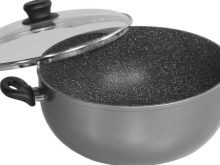

Enameled
Enamel is an ideal option for cast iron, as it closes the external pores that can harm food. It seems to seal them, allowing heat to persist even longer. Enamel can be of different types.
- Black. It is found in rough black pots. On closer inspection, one can see blotches of small grains of sand.
- White. More correctly, such an enamel is glass ceramic. In production, cast-iron dishes are dipped in liquid material, and then dried in a special oven. Thus, the enamel "sticks" to the pan.
- Non-stick. One of the best options. In the manufacture of such a coating, various components are added to it to enhance the non-stick qualities.
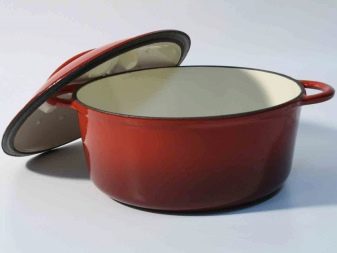
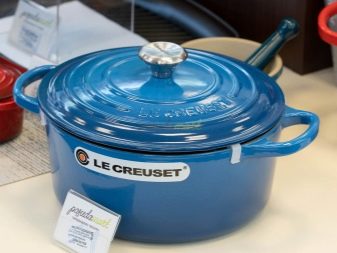
Dimensions
The size of the pan is its diameter. There are large, medium and small specimens. The diameter of the bottom of small pots is 18 cm or less. Medium dishes are 20 cm, large - 24 cm and more, up to 30 cm. You can decide as follows:
- small pots from 11 to 18 cm are suitable for cooking eggs, sausages, a small portion of porridge or soup;
- models from 18 to 20 cm are suitable for frying and stewing meat, pilaf, warming food for the family;
- products over 20 cm are needed for cooking first courses for a large family.
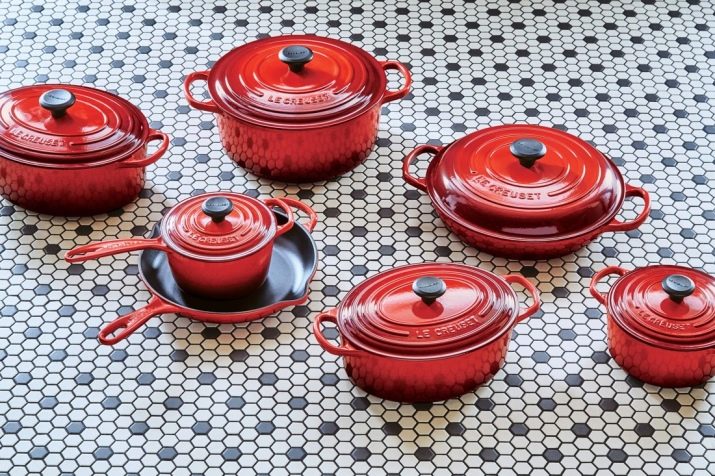
The dimensional parameters of products also include volume, depth and wall thickness.
The volume is directly proportional to the diameter of the pan. The larger the diameter, the more food can be made. There are both liter saucepans and 6 liter models. As for the depth (height), there are products from 11 to 36 cm on sale. The standard wall thickness of the cast-iron pan is 4.5 mm.

Popular models
It is worth considering in more detail popular models.
- One of the best models on the market are American KitchenAid Pans. They have a lid-pan grill, will be the best solution for baked food. The volume of such pans is 3.7 liters. The most popular color is red, but there are other colors in this line.
- Rondell is a German manufacturer, which has been pleasing its customers with quality products for 30 years. An excellent solution is the Rondell Noble Red model, its wall thickness is 4.5 mm, the bottom is 6.5 mm. Volume - 4.2 liters, a booklet with recipes is a gift for the item.
- French pans Le Creuset from the Marseille range - A great purchase for those who love bright colors. In the assortment there are models of green, purple, blue, blue, orange shades. The diameter of the pan is 18 cm; you can bake the whole bird in it.
- Mallony is a Chinese-made model. Its volume is 3 liters, suitable for all types of stoves, as well as for open fire. Color is standard black. In this line there is another pan - with a diameter of 24 cm and a volume of 4.5 liters.
- Another German manufacturer is Gipfel. For example, one of the models of this company is a Select Orange product. The color of this saucepan is yellow, the volume is 3 liters, a glass cover is included. The cast iron enameled model of 7 liters looks more massive, Saria.
- Siton is a Ukrainian company, which has long been engaged in the production of cast iron cookware. The thickness of the bottom of the models is 4 mm, the volume is different. The range includes items such as a WOK pan, pan without a lid and pan-lids, as well as many others.
- Biol Company It has long been known in the markets of Russia, Ukraine, CIS countries and Europe. The assortment includes cast pots of 3, 4, 6 liters with a glass lid, pans with a lid and frying pan of the same volume.
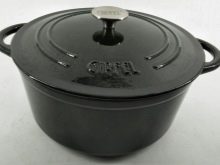
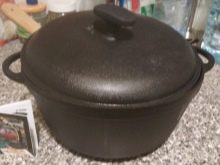

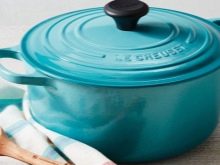
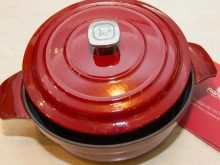
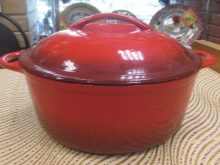
Important! Among the pots of Russian manufacture, products from the Balezinsky foundry and mechanical plant, as well as models from the Kama Posuda factory, have proven themselves well.
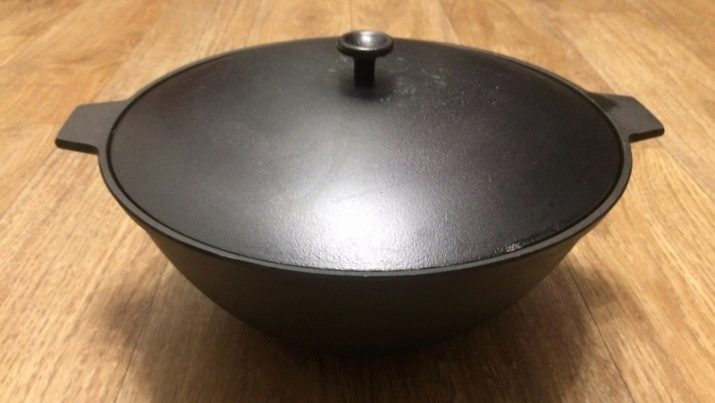
The nuances of choice
Arriving at the store for a purchase, determine the size of the pan. If you live alone, buy a model with a diameter of 12-18 cm, if a large family - from 20 cm and above. Consider also the depth parameters - if the pan is too high, it will not fit in the refrigerator.
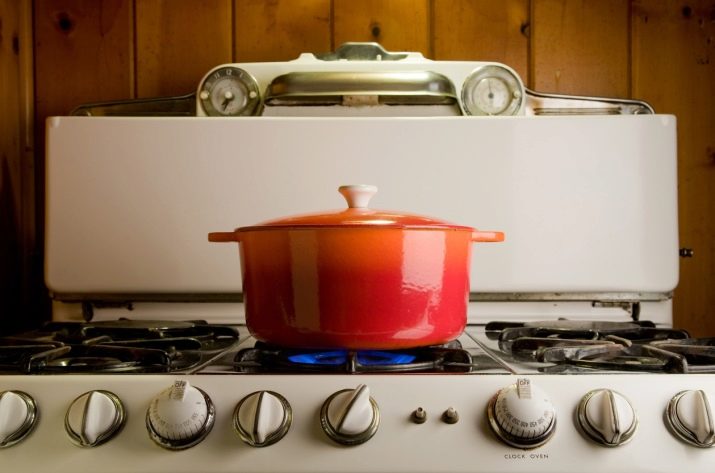
An important nuance is compatibility with plates.
The gas stove will "accept" any dishes, there is nothing to worry about, but an electric stove will require a perfectly flat bottom. Some pan models are also suitable for induction cookers, but make sure you choose the right product. As a rule, Induction should be on the pan.
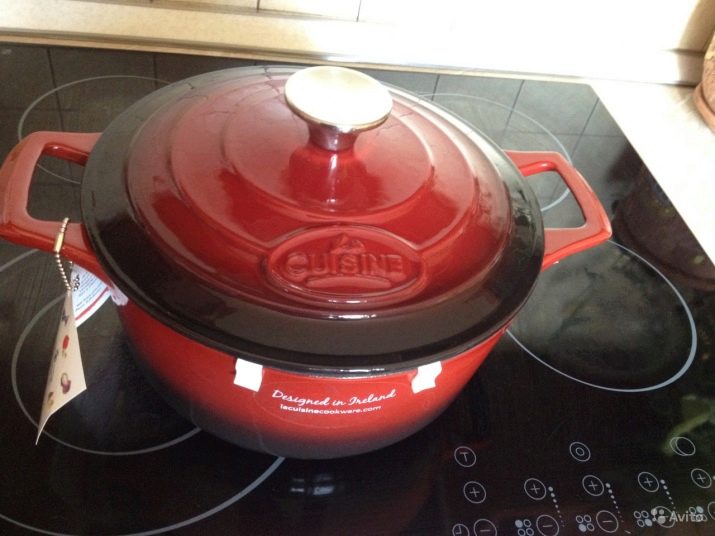
Another point is the covers. They are made of different materials, mainly glass and cast iron itself. Almost everyone likes glass most of all - through them you can watch food, and there is also a hole for steam to escape. The cast-iron lid is heavy, but it will create complete tightness, preventing aromas from rushing out. Particularly interesting are the lid-pans; there is no handle on them. Such a lid can be used as a pan or covered with a pot. A similar model is also suitable for induction cookers.
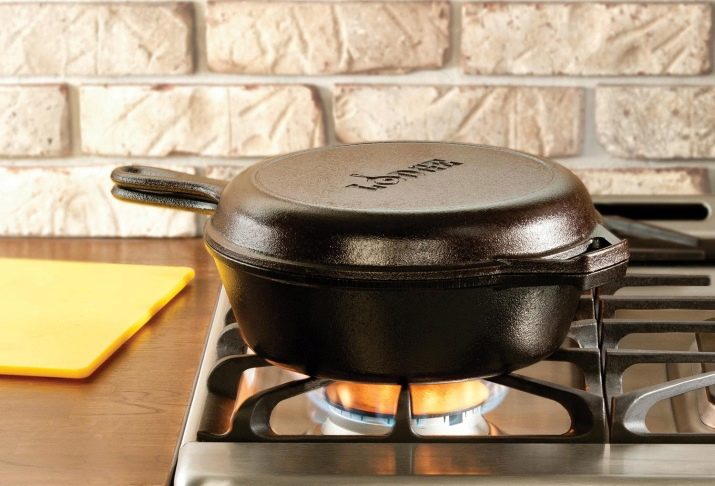
When buying, it is worth considering the handle of the pan.
Cast iron handles are strong and reliable, but they quickly heat up, so do not forget tacks.
Steel ones usually remain cool, but this does not apply to the case when an adjacent burner is heated next to the pan. Wooden handles can be found only in small pots, if this option is to your liking, choose only removable ones.
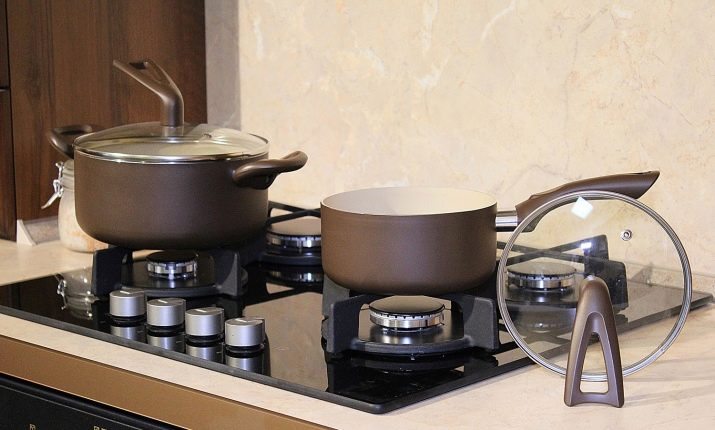
The following additional criteria should be considered:
- in the case of an induction cooker, the diameter of the pan must coincide with the diameter of the burner itself;
- if you plan to bake something in the oven, you should choose a saucepan with low sides;
- be careful with non-stick coatings - they may not withstand an open fire or oven, always ask for the maximum operating temperature before buying.
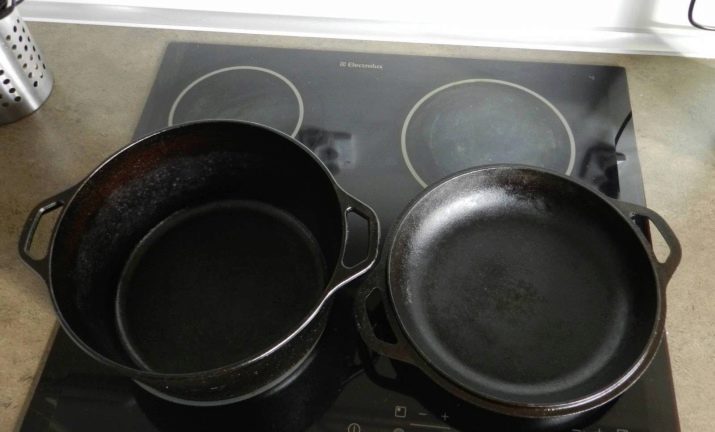
Care Rules
Consider how to calcine cast iron pots at home, namely:
- clean the pan from the factory grease; for this, wash it in hot water using a dishwashing liquid using a soft sponge;
- Wipe the surface thoroughly with a cloth so that it is completely dry;
- many manufacturers in the instructions indicate how to burn dishes; if there is no such indication, go to the next paragraph.
- open the windows in the kitchen and close the door tightly, lay the foil on the bottom of the oven so that the appliance does not get dirty, put it warm up to +170 degrees;
- Smear the pan evenly with vegetable oil, for convenience, apply a brush; turn over the greased dishes and put them in the oven for 30 minutes, then pull them out and grease again, put them back at the same time;
- then remove the pan, wait for cooling and wipe.
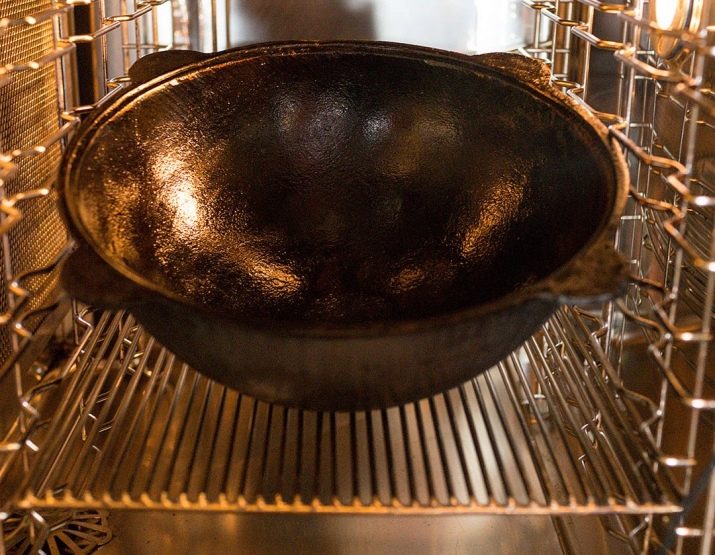
Important: the above instructions apply only to uncoated pans. In no case should you bake enameled or any other utensils.
Subsequently, the pan should be washed after each use. Do not delay this process, but remember that a hot object should not be infused with cold water. Be sure to dry the product dry; moisture cannot remain inside the pan. It is preferable to wash cast iron dishes by hand, the dishwasher is not recommended. If the pan rusts, it means that you made a mistake somewhere. To clean a rusty product, pour a little soda on its bottom, and then add water. Rub the rusty fragments with the resulting paste, then wait a few minutes and rinse.
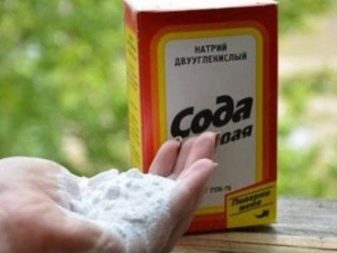

In this video you will get acquainted with the production process of cast iron cookware with enamel coating and the secrets of its use.
